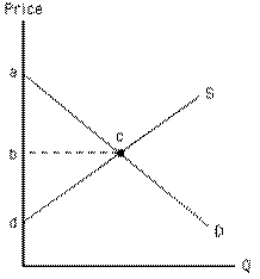Multiple Choice
Exhibit 6-14  In Exhibit 6-14, consumer surplus at a price of $2 is the difference between what consumers are willing to
In Exhibit 6-14, consumer surplus at a price of $2 is the difference between what consumers are willing to
A) pay for a quantity of goods and what they actually pay, represented by triangle abc
B) pay for a quantity of goods and what they actually pay, represented by triangle dcb
C) pay for a quantity of goods and what they actually pay, represented by triangle adc
D) receive for a good and what they actually get, represented by triangle abc
E) receive for a good and what they actually get, represented by triangle dcb
Correct Answer:

Verified
Correct Answer:
Verified
Q2: Exhibit 6-1 <img src="https://d2lvgg3v3hfg70.cloudfront.net/TB6784/.jpg" alt="Exhibit 6-1
Q3: Which of the following sayings describes the
Q4: Exhibit 6-21 <img src="https://d2lvgg3v3hfg70.cloudfront.net/TB6784/.jpg" alt="Exhibit 6-21
Q5: Total utility can be calculated as the<br>A)sum
Q6: Basil is maximizing his utility from consuming
Q8: Suppose Jerry consumes three hamburgers at McDonald's
Q9: If an individual's demand is elastic and
Q10: Marginal utility is defined as the<br>A)average amount
Q11: To derive a demand curve using utility
Q12: Demand curves usually slope downward because of